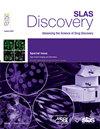Development of novel high-throughput biochemical competition assays to identify ligands of human asialoglycoprotein receptor 1
IF 2.7
4区 生物学
Q2 BIOCHEMICAL RESEARCH METHODS
引用次数: 0
Abstract
Hepatocyte-specific Asialoglycoprotein receptor (ASGPR) and its native ligand N-acetylgalactosamine (GalNAc) have been actively exploited for targeted delivery of therapeutic and diagnostic agents to the liver. Identification of new potent ligands of ASGPR is of high interest to advance this field and expand to new applications in drug discovery. However, success of novel potent ASGPR ligand discovery has been limited due to the lack of robust high-throughput assays amenable to High-Throughput Screening (HTS). Here, we describe the design and development of two novel biochemical competition binding assays using recombinant human trimeric ASGR1 protein (ASGPR subunit 1) as a mimic of the native multimeric complex and a reference Alexa-647 fluorophore-labelled tri-GalNAc ligand as a tracer. Both ASGR1 TR-FRET and fluorescence polarization (FP) assays are in 384-well microplate format and have a large detection range (IC50 of 2.5 nM - 100 µM), suitable for both monovalent and multivalent ASGPR ligands as well as oligonucleotide conjugates. The ASGR1 FP assay was miniaturized into a 1536-well assay format and a pilot screen of a small molecule library of about 7500 compounds was conducted, identifying 23 positive hits with IC50 values between 12 - 100 µM. Five of the primary hits were validated in orthogonal TR-FRET and SPR binding assays and one of them was successfully docked into the ASGPR, with the docking pose closely matching the binding mode of structurally analogous compound found to be co-crystalized with ASGR1. The successful development of these new ASGR1 biochemical assays provides a new platform for an HTS campaign on small molecule collections to discover novel ASGPR ligands for liver-targeted delivery of efficient therapeutic agents, LYTACs or as potential drugs.
新型高通量生物化学竞争法鉴定人asialglyprotein receptor 1配体的建立
肝细胞特异性亚洲糖蛋白受体(ASGPR)及其天然配体n -乙酰半乳糖胺(GalNAc)已被积极用于靶向递送治疗和诊断药物到肝脏。发现新的ASGPR有效配体对该领域的发展和药物开发具有重要意义。然而,由于缺乏适用于高通量筛选(HTS)的强大的高通量分析,新型有效ASGPR配体发现的成功受到限制。在这里,我们描述了两种新的生化竞争结合试验的设计和开发,使用重组人三聚体ASGR1蛋白(ASGPR亚基1)作为天然多聚体复合物的模拟物和参考Alexa-647荧光团标记的三galnac配体作为示踪剂。ASGR1 TR-FRET和荧光偏振(FP)检测均采用384孔微孔板格式,具有较大的检测范围(IC50为2.5 nM - 100µM),适用于单价和多价ASGPR配体以及寡核苷酸偶联物。ASGR1 FP分析被缩小为1536孔的分析格式,并对大约7500个化合物的小分子文库进行了先导筛选,鉴定出23个阳性点,IC50值在12 - 100µM之间。通过正交TR-FRET和SPR结合实验验证了5个主要命中位点,其中1个成功对接ASGPR,对接姿态与ASGR1共晶结构类似化合物的结合模式非常接近。这些新的ASGR1生化检测方法的成功开发为小分子收集的HTS运动提供了一个新的平台,以发现新的ASGPR配体,用于肝脏靶向递送有效的治疗药物lytac或潜在药物。
本文章由计算机程序翻译,如有差异,请以英文原文为准。
求助全文
约1分钟内获得全文
求助全文
来源期刊

SLAS Discovery
Chemistry-Analytical Chemistry
CiteScore
7.00
自引率
3.20%
发文量
58
审稿时长
39 days
期刊介绍:
Advancing Life Sciences R&D: SLAS Discovery reports how scientists develop and utilize novel technologies and/or approaches to provide and characterize chemical and biological tools to understand and treat human disease.
SLAS Discovery is a peer-reviewed journal that publishes scientific reports that enable and improve target validation, evaluate current drug discovery technologies, provide novel research tools, and incorporate research approaches that enhance depth of knowledge and drug discovery success.
SLAS Discovery emphasizes scientific and technical advances in target identification/validation (including chemical probes, RNA silencing, gene editing technologies); biomarker discovery; assay development; virtual, medium- or high-throughput screening (biochemical and biological, biophysical, phenotypic, toxicological, ADME); lead generation/optimization; chemical biology; and informatics (data analysis, image analysis, statistics, bio- and chemo-informatics). Review articles on target biology, new paradigms in drug discovery and advances in drug discovery technologies.
SLAS Discovery is of particular interest to those involved in analytical chemistry, applied microbiology, automation, biochemistry, bioengineering, biomedical optics, biotechnology, bioinformatics, cell biology, DNA science and technology, genetics, information technology, medicinal chemistry, molecular biology, natural products chemistry, organic chemistry, pharmacology, spectroscopy, and toxicology.
SLAS Discovery is a member of the Committee on Publication Ethics (COPE) and was published previously (1996-2016) as the Journal of Biomolecular Screening (JBS).
 求助内容:
求助内容: 应助结果提醒方式:
应助结果提醒方式:


